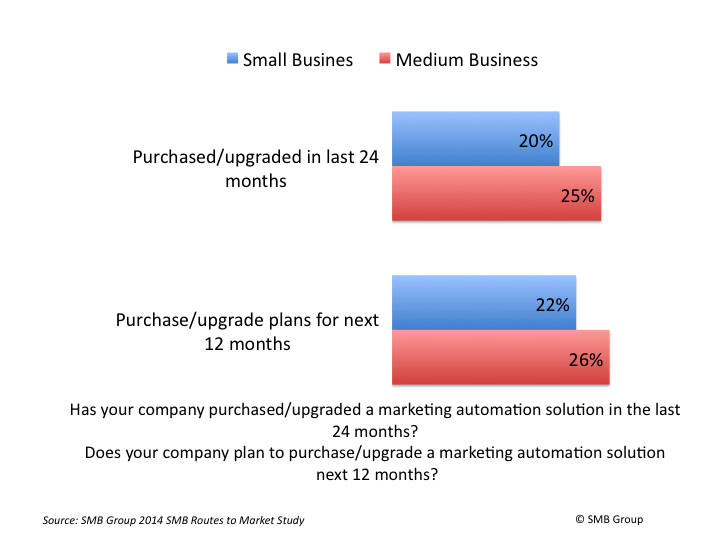This is the first post in a blog series discussing key marketing automation trends for SMBs. This series is excerpted from SMB Group’s December 2014 report, SMB Group Perspectives Report: Top Trends in Marketing Automation and How Vendors Are Helping SMBs to Capitalize on Them, which provides detailed information and insights to help SMBs capitalize on these trends.
Choosing a marketing automation solution may be one of the most important decisions your business makes. As cloud, mobile, social, analytics and other technologies continue to transform the buyer’s journey, this choice is likely to become even more critical.
As the term “marketing automation” implies, small and medium businesses (SMBs) must automate tasks to scale their marketing campaigns in order to reach more prospects and customers, and to provide them with the right information at the right time in their buying journey. Although many small and even medium businesses rely on point solutions, more are turning to an integrated marketing approach. In 2014, 20% of small and 25% of medium businesses had purchased/upgraded to a marketing automation solution in the past 24 months. Meanwhile, 22% of small and 26% of medium businesses plan to purchase/upgrade a marketing automation solution in the next 12 months, as indicated in SMB Group’s 2014 SMB Routes to Market Study.
Figure 1: SMB Marketing Automation Adoption and Plans
However, marketing requirements are changing rapidly. Today, buyers conduct much of their research and evaluation online across multiple channels. Because businesses need to be where their customers and prospects are, they must invest to build their digital footprint via websites, social media engagement, search, email marketing and mobile marketing. Simultaneously, they must continue to invest in traditional marketing activities.
SMB Group has identified several key trends that SMBs should consider when selecting a marketing automation solution, including:
- Cloud computing: The cloud is quickly becoming the preferred deployment method for marketing automation because it relieves SMBs of IT deployment and management issues.
- Mobile: Buyers are doing more research, shopping and buying on mobile devices, and SMBs must optimize the buying journey on these devices. At a basic level, this means, for instance, that email campaigns and websites need to be automatically rendered and optimized for devices from laptops to smartphones. But many more areas also need to be addressed. For instance, should an SMB develop mobile apps or mobile websites, or use text messaging to connect with customers—or all of the above?
- Social: Social media has become the equivalent of digital word of mouth, and SMBs need solutions to help them observe, participate in and track the social networks that their prospects and customers use in order to engage and nurture relationships.
- Content: Content feeds all marketing initiatives and is critical to establishing and sustaining customer relationships. But creating good content is often difficult and time-consuming. SMBs must be able to produce, distribute and repackage content more effectively so they get more value from it.
- Omnichannel: As the buyer journey evolves to include more touch points, SMBs need to create and maintain a consistent look and feel across different channels as well as gain an integrated view of customer behavior.
Fortunately, many vendors offer solutions to help SMBs capitalize on these trends. But given so many choices, SMBs must carefully evaluate and compare all the options in order to get the best fit for their requirements. Key areas to investigate include:
- How vendors define “SMB” and position their offerings: Most focus on a particular slice of the SMB market because it’s difficult to satisfy the diverse requirements across the broader SMB market.
- How many and what percentage of the vendor’s customers are from the SMB segment the vendor targets
- How well the solution maps to a company’s needs and constraints: Some vendors focus on providing very in-depth marketing automation capabilities, while others combine marketing with CRM in a pre-integrated suite.
- Internal marketing resources and skills, and whether to take more of a do-it-yourself versus a do-it-for-me approach
- Pricing, including whether a vendor offers annual, monthly and/or yearly contracts
- Integration of different marketing and sales activities to gain a unified view of customer and prospects: This is a key driver for marketing automation.
- CRM tools that need to be integrated: Pure-play marketing automation vendors usually integrate with multiple CRM solutions, while others provide a pre-integrated suite that includes marketing and CRM.
- How to feed the marketing funnel: Marketing automation without compelling content is like a car without gas. Content nurtures the buyer through the sales funnel. Although you can’t really automate content creation, you can streamline it. Some vendors offer education and even services to help.
- Tools, services and support programs to help you get the most from the platform, both in the near term and in the future as needs evolve
Vendors have designed their solutions for different types of SMB requirements; there is no one-size-fits-all. In subsequent posts in this series, we examine these requirements and vendor (Act-On, HubSpot, Infusionsoft, IBM Silverpop, NetSuite, ReachLocal, Salesforce.com Pardot, SugarCRM) strategies for SMBs in more detail.
For more information about the full report, SMB Group Perspectives Report: Top Trends in Marketing Automation and How Vendors Are Helping SMBs to Capitalize on Them, please contact Lisa Lincoln, Director, Client Services & Business Development: 508.734.5658 or lisa.lincoln70@smb-gr.com.

